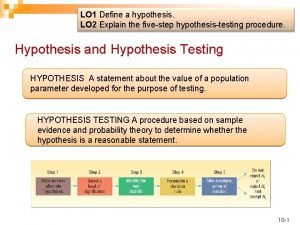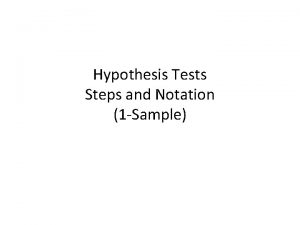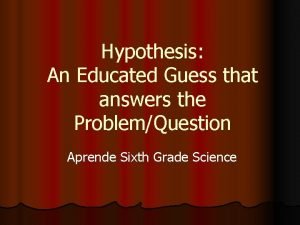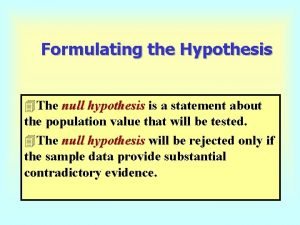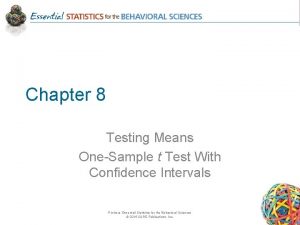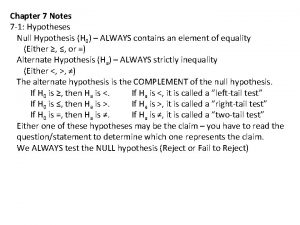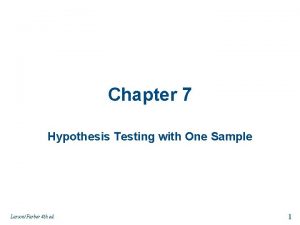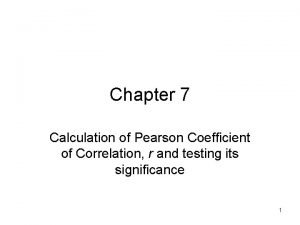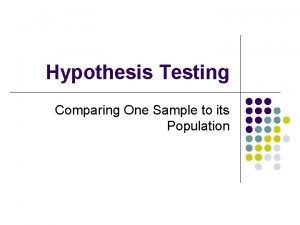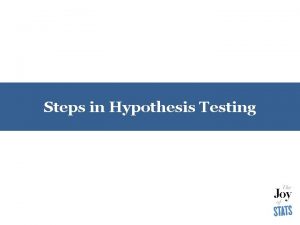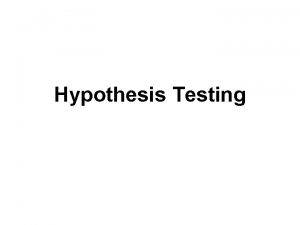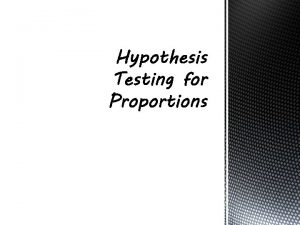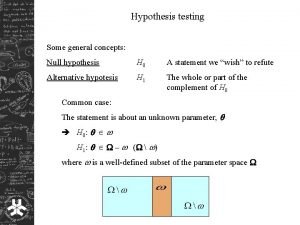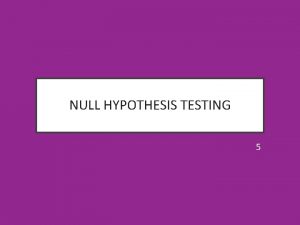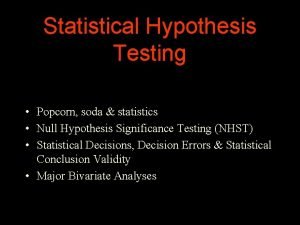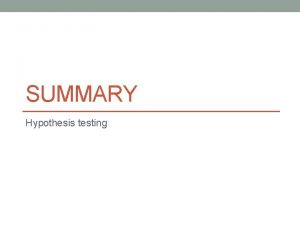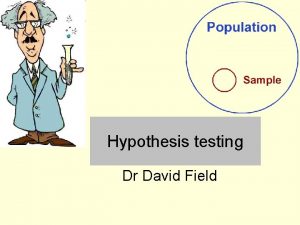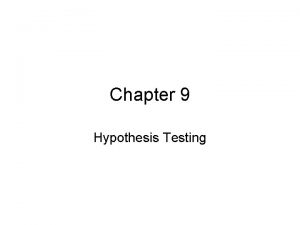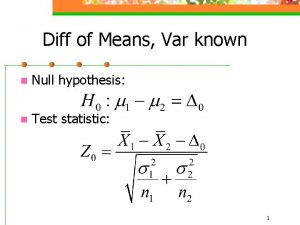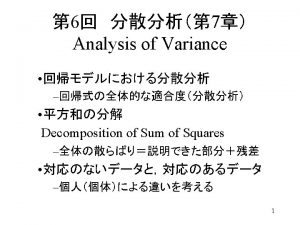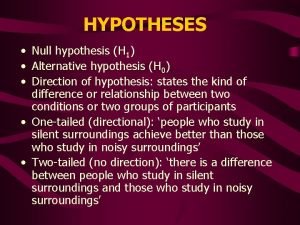Hypothesis Testing Null Hypothesis The means of the



















- Slides: 19

Hypothesis Testing

Null Hypothesis: The means of the populations from which the samples were drawn are the same. The samples come from the same population. m G/R

Alternative Hypothesis: The means of the populations from which the samples were drawn are different. The samples come from different populations. m G m R

Our problem: All we see are the data we have sampled, not the populations.

Are the sampled data most consistent with the null hypothesis “single population” idea? m G/R

Or with the alternative hypothesis “separate populations” idea, m G m R

Distribution of differences between the means of two samples drawn from the same population (m=0, s=1) 0 -0. 6 -0. 5 -0. 4 -0. 3 -0. 2 -0. 1 0 1 11 65 120 21 15 9 54 100 189 214 183 118 200 0 Frequency (Probability *1000) 300 0. 1 0. 2 0. 3 0. 4 0. 5 0. 6 Difference Between the Means of the Samples


“What is the probability that the observed samples could have been drawn from the same population? ” m P=0. 79 x G/R x

Distribution of differences between the means of two samples drawn from the same population (m=0, s=1) 120 189 214 183 118 200 0 -0. 6 -0. 5 -0. 4 -0. 3 -0. 2 -0. 1 0 1 11 65 21 15 9 54 100 0 Frequency (Probability *1000) 300 0. 1 0. 2 0. 3 0. 4 0. 5 0. 6 Difference Between the Means of the Samples

“What is the probability that the observed samples could have been drawn from the same population? ” m P=0. 18 x G/R x

Distribution of differences between the means of two samples drawn from the same population (m=0, s=1) 120 189 214 183 118 200 0 -0. 6 -0. 5 -0. 4 -0. 3 -0. 2 -0. 1 0 1 11 65 21 15 9 54 100 0 Frequency (Probability *1000) 300 0. 1 0. 2 0. 3 0. 4 0. 5 0. 6 Difference Between the Means of the Samples

“What is the probability that the observed samples could have been drawn from the same population? ” m P=0. 02 x G/R x

Distribution of differences between the means of two samples drawn from the same population (m=0, s=1) 120 189 214 183 118 200 0 -0. 6 -0. 5 -0. 4 -0. 3 -0. 2 -0. 1 0 1 11 65 21 15 9 54 100 0 Frequency (Probability *1000) 300 0. 1 0. 2 0. 3 0. 4 0. 5 0. 6 Difference Between the Means of the Samples

The Dilemma How much risk to take when deciding whether the null or alternative hypothesis is correct? Too much risk and you may commit a Type I error – rejection of a true null hypothesis (accepting a false Alternative - deciding samples are different when they are the same). Too little risk and you may commit a Type II error – failure to reject a false null hypothesis (accepting a false null - deciding samples are the same when they are different). The accepted risk level is set at 0. 05 or a 1 out of 20 chance that you will accidentally accept a false alternative – commit Type I error. Statistical tables are set to this level of risk.

More on Type I and II Errors • Sometimes in medical studies we seek to lower the chance of Type I errors (rejecting a true null hypothesis) and we may set the level for rejecting the null hypothesis lower – such as p = 0. 01 or a 1 in 100 chance of committing Type I error • Decreasing chance of Type I error will increase the chance of Type II error • The only way to simultaneously reduce the risk of Type I and Type II errors is to increase sample size

Measurements of Central Tendency Data Set: 2 red, 3 blue, 1 green, 2 yellow, 2 black Frequency Histogram - 3 2 1 red blue green yellow black Mean - sum of data divided by the number of data points Median - middlemost data point when data are arrayed in sequence (lowest to highest) Mode - most frequently occurring value

Measurements of Dispersion Data Set: Student A B C D E F G Exam I 90 95 85 90 95 Exam II 100 80 70 85 95 100 Range: highest and lowest values Variance: s 2 = 2 x) 2 x – n n– 1 Standard Deviation: the square root of variance

 Hypotheses in research example
Hypotheses in research example Null and alternative hypothesis statistics
Null and alternative hypothesis statistics Null and alternative hypothesis statistics
Null and alternative hypothesis statistics One way anova null hypothesis
One way anova null hypothesis How to find the critical values
How to find the critical values Research hypothesis
Research hypothesis Hypothesis for two way anova
Hypothesis for two way anova Standard deviation null hypothesis
Standard deviation null hypothesis Hypothesis paragraph example
Hypothesis paragraph example Null hypothesis assumptions
Null hypothesis assumptions Hypothesis educated guess
Hypothesis educated guess Null hypothesis
Null hypothesis Critical chi square value
Critical chi square value Effect size for t-test
Effect size for t-test Examples of null hypothesis
Examples of null hypothesis P-value two tailed test
P-value two tailed test Ssxx equation
Ssxx equation What is a directional hypothesis in psychology
What is a directional hypothesis in psychology Hypothesis testing formula
Hypothesis testing formula Chi square ap biology
Chi square ap biology







